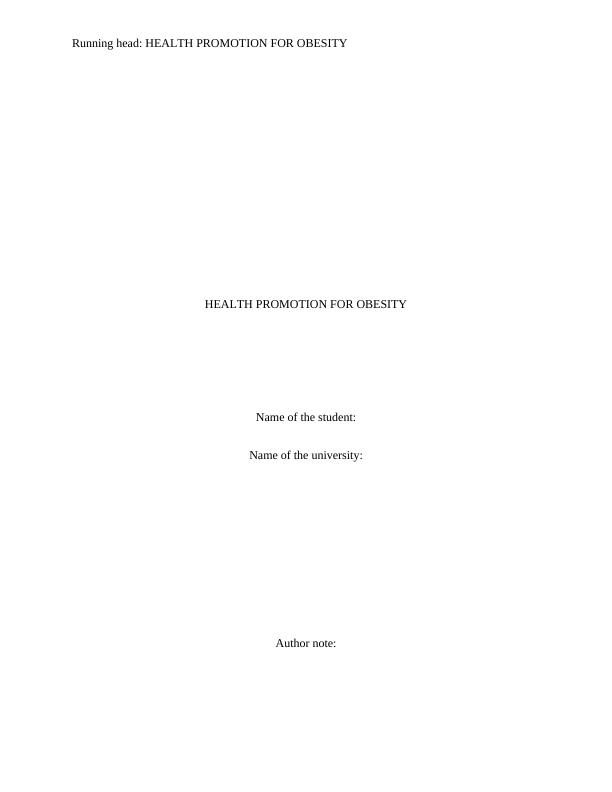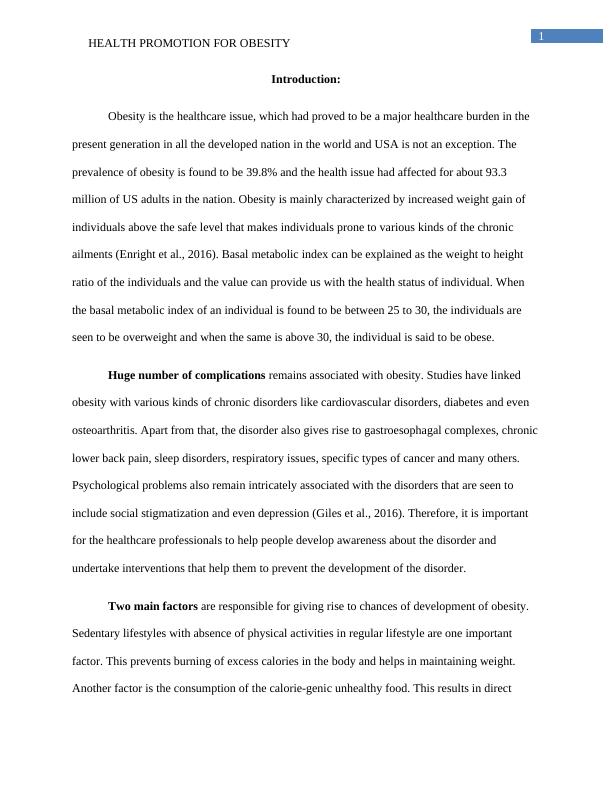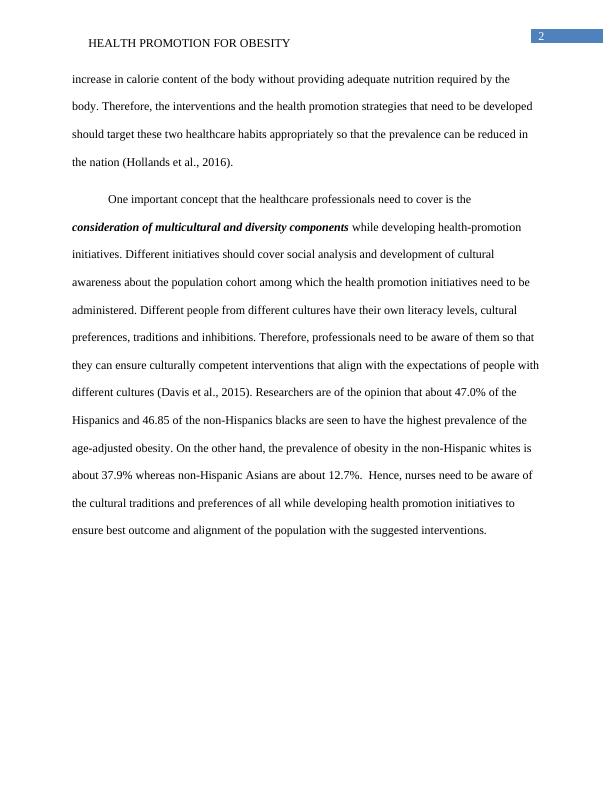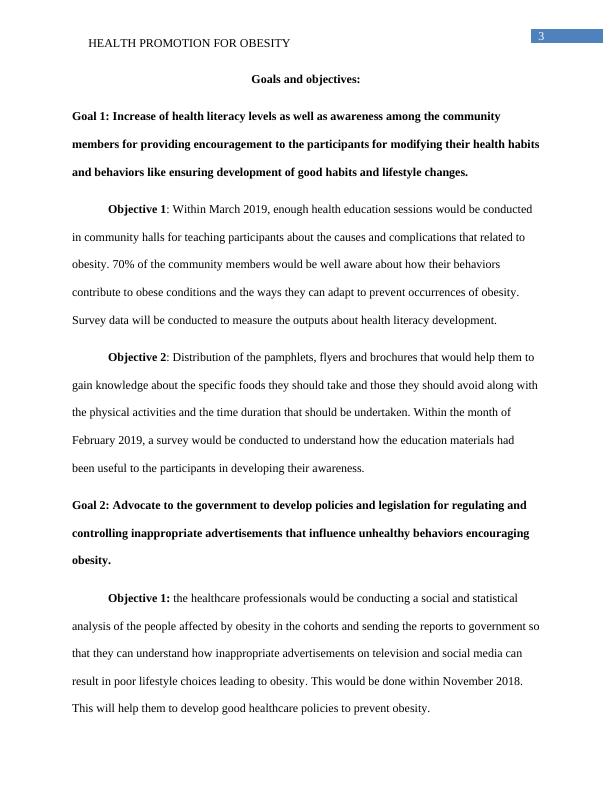Health Promotion for Obesity
Added on 2023-05-29
15 Pages3627 Words456 Views
Running head: HEALTH PROMOTION FOR OBESITY
HEALTH PROMOTION FOR OBESITY
Name of the student:
Name of the university:
Author note:
HEALTH PROMOTION FOR OBESITY
Name of the student:
Name of the university:
Author note:

1
HEALTH PROMOTION FOR OBESITY
Introduction:
Obesity is the healthcare issue, which had proved to be a major healthcare burden in the
present generation in all the developed nation in the world and USA is not an exception. The
prevalence of obesity is found to be 39.8% and the health issue had affected for about 93.3
million of US adults in the nation. Obesity is mainly characterized by increased weight gain of
individuals above the safe level that makes individuals prone to various kinds of the chronic
ailments (Enright et al., 2016). Basal metabolic index can be explained as the weight to height
ratio of the individuals and the value can provide us with the health status of individual. When
the basal metabolic index of an individual is found to be between 25 to 30, the individuals are
seen to be overweight and when the same is above 30, the individual is said to be obese.
Huge number of complications remains associated with obesity. Studies have linked
obesity with various kinds of chronic disorders like cardiovascular disorders, diabetes and even
osteoarthritis. Apart from that, the disorder also gives rise to gastroesophagal complexes, chronic
lower back pain, sleep disorders, respiratory issues, specific types of cancer and many others.
Psychological problems also remain intricately associated with the disorders that are seen to
include social stigmatization and even depression (Giles et al., 2016). Therefore, it is important
for the healthcare professionals to help people develop awareness about the disorder and
undertake interventions that help them to prevent the development of the disorder.
Two main factors are responsible for giving rise to chances of development of obesity.
Sedentary lifestyles with absence of physical activities in regular lifestyle are one important
factor. This prevents burning of excess calories in the body and helps in maintaining weight.
Another factor is the consumption of the calorie-genic unhealthy food. This results in direct
HEALTH PROMOTION FOR OBESITY
Introduction:
Obesity is the healthcare issue, which had proved to be a major healthcare burden in the
present generation in all the developed nation in the world and USA is not an exception. The
prevalence of obesity is found to be 39.8% and the health issue had affected for about 93.3
million of US adults in the nation. Obesity is mainly characterized by increased weight gain of
individuals above the safe level that makes individuals prone to various kinds of the chronic
ailments (Enright et al., 2016). Basal metabolic index can be explained as the weight to height
ratio of the individuals and the value can provide us with the health status of individual. When
the basal metabolic index of an individual is found to be between 25 to 30, the individuals are
seen to be overweight and when the same is above 30, the individual is said to be obese.
Huge number of complications remains associated with obesity. Studies have linked
obesity with various kinds of chronic disorders like cardiovascular disorders, diabetes and even
osteoarthritis. Apart from that, the disorder also gives rise to gastroesophagal complexes, chronic
lower back pain, sleep disorders, respiratory issues, specific types of cancer and many others.
Psychological problems also remain intricately associated with the disorders that are seen to
include social stigmatization and even depression (Giles et al., 2016). Therefore, it is important
for the healthcare professionals to help people develop awareness about the disorder and
undertake interventions that help them to prevent the development of the disorder.
Two main factors are responsible for giving rise to chances of development of obesity.
Sedentary lifestyles with absence of physical activities in regular lifestyle are one important
factor. This prevents burning of excess calories in the body and helps in maintaining weight.
Another factor is the consumption of the calorie-genic unhealthy food. This results in direct

2
HEALTH PROMOTION FOR OBESITY
increase in calorie content of the body without providing adequate nutrition required by the
body. Therefore, the interventions and the health promotion strategies that need to be developed
should target these two healthcare habits appropriately so that the prevalence can be reduced in
the nation (Hollands et al., 2016).
One important concept that the healthcare professionals need to cover is the
consideration of multicultural and diversity components while developing health-promotion
initiatives. Different initiatives should cover social analysis and development of cultural
awareness about the population cohort among which the health promotion initiatives need to be
administered. Different people from different cultures have their own literacy levels, cultural
preferences, traditions and inhibitions. Therefore, professionals need to be aware of them so that
they can ensure culturally competent interventions that align with the expectations of people with
different cultures (Davis et al., 2015). Researchers are of the opinion that about 47.0% of the
Hispanics and 46.85 of the non-Hispanics blacks are seen to have the highest prevalence of the
age-adjusted obesity. On the other hand, the prevalence of obesity in the non-Hispanic whites is
about 37.9% whereas non-Hispanic Asians are about 12.7%. Hence, nurses need to be aware of
the cultural traditions and preferences of all while developing health promotion initiatives to
ensure best outcome and alignment of the population with the suggested interventions.
HEALTH PROMOTION FOR OBESITY
increase in calorie content of the body without providing adequate nutrition required by the
body. Therefore, the interventions and the health promotion strategies that need to be developed
should target these two healthcare habits appropriately so that the prevalence can be reduced in
the nation (Hollands et al., 2016).
One important concept that the healthcare professionals need to cover is the
consideration of multicultural and diversity components while developing health-promotion
initiatives. Different initiatives should cover social analysis and development of cultural
awareness about the population cohort among which the health promotion initiatives need to be
administered. Different people from different cultures have their own literacy levels, cultural
preferences, traditions and inhibitions. Therefore, professionals need to be aware of them so that
they can ensure culturally competent interventions that align with the expectations of people with
different cultures (Davis et al., 2015). Researchers are of the opinion that about 47.0% of the
Hispanics and 46.85 of the non-Hispanics blacks are seen to have the highest prevalence of the
age-adjusted obesity. On the other hand, the prevalence of obesity in the non-Hispanic whites is
about 37.9% whereas non-Hispanic Asians are about 12.7%. Hence, nurses need to be aware of
the cultural traditions and preferences of all while developing health promotion initiatives to
ensure best outcome and alignment of the population with the suggested interventions.

3
HEALTH PROMOTION FOR OBESITY
Goals and objectives:
Goal 1: Increase of health literacy levels as well as awareness among the community
members for providing encouragement to the participants for modifying their health habits
and behaviors like ensuring development of good habits and lifestyle changes.
Objective 1: Within March 2019, enough health education sessions would be conducted
in community halls for teaching participants about the causes and complications that related to
obesity. 70% of the community members would be well aware about how their behaviors
contribute to obese conditions and the ways they can adapt to prevent occurrences of obesity.
Survey data will be conducted to measure the outputs about health literacy development.
Objective 2: Distribution of the pamphlets, flyers and brochures that would help them to
gain knowledge about the specific foods they should take and those they should avoid along with
the physical activities and the time duration that should be undertaken. Within the month of
February 2019, a survey would be conducted to understand how the education materials had
been useful to the participants in developing their awareness.
Goal 2: Advocate to the government to develop policies and legislation for regulating and
controlling inappropriate advertisements that influence unhealthy behaviors encouraging
obesity.
Objective 1: the healthcare professionals would be conducting a social and statistical
analysis of the people affected by obesity in the cohorts and sending the reports to government so
that they can understand how inappropriate advertisements on television and social media can
result in poor lifestyle choices leading to obesity. This would be done within November 2018.
This will help them to develop good healthcare policies to prevent obesity.
HEALTH PROMOTION FOR OBESITY
Goals and objectives:
Goal 1: Increase of health literacy levels as well as awareness among the community
members for providing encouragement to the participants for modifying their health habits
and behaviors like ensuring development of good habits and lifestyle changes.
Objective 1: Within March 2019, enough health education sessions would be conducted
in community halls for teaching participants about the causes and complications that related to
obesity. 70% of the community members would be well aware about how their behaviors
contribute to obese conditions and the ways they can adapt to prevent occurrences of obesity.
Survey data will be conducted to measure the outputs about health literacy development.
Objective 2: Distribution of the pamphlets, flyers and brochures that would help them to
gain knowledge about the specific foods they should take and those they should avoid along with
the physical activities and the time duration that should be undertaken. Within the month of
February 2019, a survey would be conducted to understand how the education materials had
been useful to the participants in developing their awareness.
Goal 2: Advocate to the government to develop policies and legislation for regulating and
controlling inappropriate advertisements that influence unhealthy behaviors encouraging
obesity.
Objective 1: the healthcare professionals would be conducting a social and statistical
analysis of the people affected by obesity in the cohorts and sending the reports to government so
that they can understand how inappropriate advertisements on television and social media can
result in poor lifestyle choices leading to obesity. This would be done within November 2018.
This will help them to develop good healthcare policies to prevent obesity.

End of preview
Want to access all the pages? Upload your documents or become a member.
Related Documents
Screening Program for Obesity - Importance, Benefits, and Recommendationslg...
|7
|1898
|187
Obesity Prevention and Health Promotionlg...
|14
|3383
|96
Interventions for Obesity: Morning Walks and Healthy Eatinglg...
|10
|2855
|54
Theory of Interventions for Obesity Managementlg...
|12
|3267
|97
Health Promotion Program for Childhood Obesity Preventionlg...
|7
|979
|220
Community Health and Disease Preventionlg...
|14
|3276
|36
